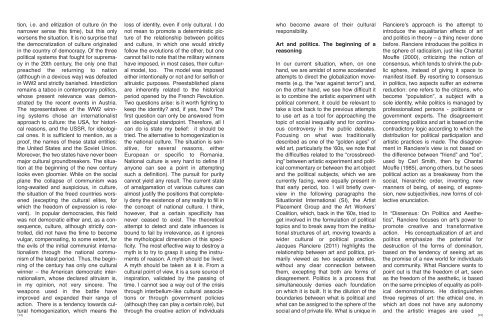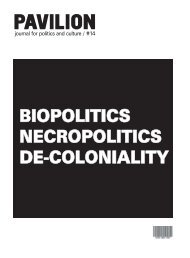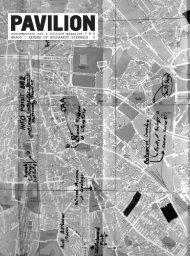Download pdf version of issue no. 16 (4 Mb) - Pavilion
Download pdf version of issue no. 16 (4 Mb) - Pavilion
Download pdf version of issue no. 16 (4 Mb) - Pavilion
You also want an ePaper? Increase the reach of your titles
YUMPU automatically turns print PDFs into web optimized ePapers that Google loves.
tion, i.e. and elitization <strong>of</strong> culture (in the<br />
narrower sense this time), but this only<br />
worsens the situation. It is <strong>no</strong> surprise that<br />
the democratization <strong>of</strong> culture originated<br />
in the country <strong>of</strong> democracy. Of the three<br />
political systems that fought for supremacy<br />
in the 20th century, the only one that<br />
preached the returning to nation<br />
(although in a devious way) was defeated<br />
in WW2 and strictly banished. Interdiction<br />
remains a taboo in contemporary politics,<br />
whose present relevance was demonstrated<br />
by the recent events in Austria.<br />
The representatives <strong>of</strong> the WW2 winning<br />
systems chose an internationalist<br />
approach to culture: the USA, for historical<br />
reasons, and the USSR, for ideological<br />
ones. It is sufficient to mention, as a<br />
pro<strong>of</strong>, the names <strong>of</strong> these statal entities:<br />
the United States and the Soviet Union.<br />
Moreover, the two states have never been<br />
major cultural groundbreakers. The situation<br />
at the beginning <strong>of</strong> the new century<br />
looks even gloomier. While on the social<br />
plane the collapse <strong>of</strong> communism was<br />
long-awaited and auspicious, in culture,<br />
the situation <strong>of</strong> the freed countries worsened<br />
(excepting the cultural elites, for<br />
which the freedom <strong>of</strong> expression is relevant).<br />
In popular democracies, this field<br />
was <strong>no</strong>t democratic either and, as a consequence,<br />
culture, although strictly controlled,<br />
did <strong>no</strong>t have the time to become<br />
vulgar, compensating, to some extent, for<br />
the evils <strong>of</strong> the initial communist internationalism<br />
through the national communism<br />
<strong>of</strong> the latest period. Thus, the beginning<br />
<strong>of</strong> the century has only one cultural<br />
winner – the American democratic internationalism,<br />
whose declared altruism is,<br />
in my opinion, <strong>no</strong>t very sincere. The<br />
weapons used in the battle have<br />
improved and expanded their range <strong>of</strong><br />
action. There is a tendency towards cultural<br />
homogenization, which means the<br />
[14]<br />
loss <strong>of</strong> identity, even if only cultural. I do<br />
<strong>no</strong>t mean to promote a deterministic picture<br />
<strong>of</strong> the relationship between politics<br />
and culture, in which one would strictly<br />
follow the evolutions <strong>of</strong> the other, but one<br />
can<strong>no</strong>t fail to <strong>no</strong>te that the military winners<br />
have imposed, in most cases, their cultural<br />
model, too. The model was imposed<br />
either intentionally or <strong>no</strong>t and for selfish or<br />
altruistic purposes. Preestablished plans<br />
are inherently related to the historical<br />
period opened by the French Revolution.<br />
Two questions arise: is it worth fighting to<br />
keep the identity? and, if yes, how? The<br />
first question can only be answered from<br />
an ideological standpoint. Therefore, all I<br />
can do is state my belief: it should be<br />
tried. The alternative to homogenization is<br />
the national culture. The situation is sensitive,<br />
for several reasons, either<br />
European or specific to Romania.<br />
National culture is very hard to define (if<br />
anyone can see a point in attempting<br />
such a definition). The pursuit for purity<br />
can<strong>no</strong>t yield any result. The current state<br />
<strong>of</strong> amalgamation <strong>of</strong> various cultures can<br />
almost justify the positions that completely<br />
deny the existence <strong>of</strong> any reality to fill in<br />
the concept <strong>of</strong> national culture. I think,<br />
however, that a certain specificity has<br />
never ceased to exist. The theoretical<br />
attempt to detect and date influences is<br />
bound to fail by irrelevance, as it ig<strong>no</strong>res<br />
the mythological dimension <strong>of</strong> this specificity.<br />
The most effective way to destroy a<br />
myth is to try to grasp it using the instruments<br />
<strong>of</strong> reason. A myth should be lived.<br />
A myth should be taken as it is. From a<br />
cultural point <strong>of</strong> view, it is a sure source <strong>of</strong><br />
inspiration, validated by the passing <strong>of</strong><br />
time. I can<strong>no</strong>t see a way out <strong>of</strong> the crisis<br />
through interbellum-like cultural associations<br />
or through government policies<br />
(although they can play a certain role), but<br />
through the creative action <strong>of</strong> individuals<br />
who become aware <strong>of</strong> their cultural<br />
responsibility.<br />
Art and politics. The beginning <strong>of</strong> a<br />
reasoning<br />
In our current situation, when, on one<br />
hand, we are amidst <strong>of</strong> some accelerated<br />
attempts to direct the globalization movements<br />
(e.g. the “war against terror”) and,<br />
on the other hand, we see how difficult it<br />
is to combine the artistic experiment with<br />
political comment, it could be relevant to<br />
take a look back to the previous attempts<br />
to use art as a tool for approaching the<br />
topic <strong>of</strong> social inequality and for continuous<br />
controversy in the public debates.<br />
Focusing on what was traditionally<br />
described as one <strong>of</strong> the “golden ages” <strong>of</strong><br />
wild art, particularly the ‘60s, we <strong>no</strong>te that<br />
the difficulties related to the “crossbreeding”<br />
between artistic experiment and political<br />
commentary or between the art object<br />
and the political subjects, which we are<br />
currently facing, were equally present in<br />
that early period, too. I will briefly overview<br />
in the following paragraphs the<br />
Situationist International (SI), the Artist<br />
Placement Group and the Art Workers’<br />
Coalition, which, back in the ‘60s, tried to<br />
get involved in the formulation <strong>of</strong> political<br />
topics and to break away from the institutional<br />
structures <strong>of</strong> art, moving towards a<br />
wider cultural or political practice.<br />
Jacques Ranciere (2011) highlights the<br />
relationship between art and politics, primarily<br />
viewed as two separate entities,<br />
without any clear connection between<br />
them, excepting that both are forms <strong>of</strong><br />
disagreement. Politics is a process that<br />
simultaneously denies each foundation<br />
on which it is built. It is the dilution <strong>of</strong> the<br />
boundaries between what is political and<br />
what can be assigned to the sphere <strong>of</strong> the<br />
social and <strong>of</strong> private life. What is unique in<br />
Ranciere’s approach is the attempt to<br />
introduce the equalitarian effects <strong>of</strong> art<br />
and politics in theory – a thing never done<br />
before. Ranciere introduces the politics in<br />
the sphere <strong>of</strong> radicalism, just like Chantal<br />
Mouffe (2000), criticizing the <strong>no</strong>tion <strong>of</strong><br />
consensus, which tends to shrink the public<br />
sphere, instead <strong>of</strong> giving it space to<br />
manifest itself. By resorting to consensus<br />
in politics, two aspects suffer an extreme<br />
reduction: one refers to the citizens, who<br />
become “population”, a subject with a<br />
sole identity, while politics is managed by<br />
pr<strong>of</strong>essionalized persons - politicians or<br />
government experts. The disagreement<br />
concerning politics and art is based on the<br />
contradictory logic according to which the<br />
distribution for political participation and<br />
artistic practices is made. The disagreement<br />
in Ranciere's view is <strong>no</strong>t based on<br />
the difference between “friend” and “foe”,<br />
used by Carl Smith, then by Chantal<br />
Mouffe (1985), among others, but he sees<br />
political action as a breakaway from the<br />
social, hierarchic order, inventing new<br />
manners <strong>of</strong> being, <strong>of</strong> seeing, <strong>of</strong> expression,<br />
new subjectivities, new forms <strong>of</strong> collective<br />
enunciation.<br />
In “Dissensus: On Politics and Aesthetics”,<br />
Ranciere focuses on art's power to<br />
promote creative and transformative<br />
action. His conceptualization <strong>of</strong> art and<br />
politics emphasize the potential for<br />
destruction <strong>of</strong> the forms <strong>of</strong> domination,<br />
based on the tendency <strong>of</strong> seeing art as<br />
the promise <strong>of</strong> a new world for individuals<br />
and community. What Ranciere wants to<br />
point out is that the freedom <strong>of</strong> art, seen<br />
as the freedom <strong>of</strong> the aesthetic, is based<br />
on the same principles <strong>of</strong> equality as political<br />
demonstrations. He distinguishes<br />
three regimes <strong>of</strong> art: the ethical one, in<br />
which art does <strong>no</strong>t have any auto<strong>no</strong>my<br />
and the artistic images are used [15]








